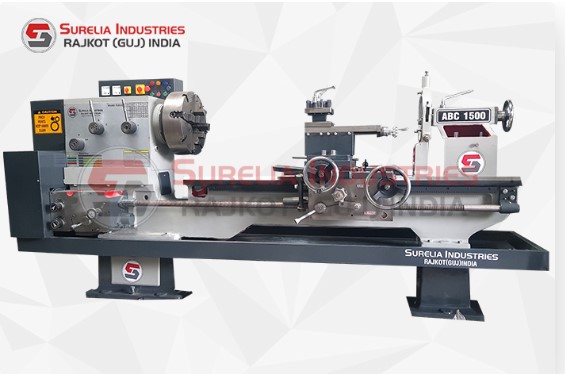
If you’re starting your journey with lathes, an all-geared variety is a great choice. The all geared lathe machine stands as a cornerstone of metalworking, offering unparalleled power, precision, and efficiency for a wide range of applications. This guide will explain its components, working principles, and advantages over other types. Also, this post will equip you with the knowledge on how to choose an all-geared lathe and keep it maintained.
An Overview of All Geared Lathe Machine
An all-geared lathe machine is a workhorse used for shaping various materials, such as metal, wood, or plastic, by rotating the workpiece against cutting tools. The term “geared” in the name refers to the presence of gears within the machine’s transmission system, which allows for controlling the speed and direction of the spindle.
Here are the components of an all-geared lathe:
- Headstock: It houses the motor, spindle, gears, and speed control. The spindle holds the workpiece and rotates it. Gears transmit power to the spindle, providing consistent torque and speed variations.
- Bed: It’s the main frame of the lathe, where the headstock, tailstock, and carriage slide along precisely machined ways.
- Carriage: Holds the cutting tool post and moves along the bed to perform cutting operations.
- Tailstock: Provides support for long workpieces and can be used for drilling and other operations.
- Toolpost: Holds the cutting tool and can be adjusted for various angles and positions.
- Gearbox: Houses the gears that control spindle speed and feed rate. In an all-geared lathe, the gearbox is typically more complex but offers wider speed ranges and smoother transitions.
Working Principle of all geared lathe machine:
- The operator mounts the workpiece in the spindle and secures it with a chuck or collet.
- Then, the motor powers the headstock gears, which transmit power to the spindle, rotating the workpiece at the desired speed.
- The operator moves the carriage along the bed, feeding the cutting tool into the rotating workpiece.
- As the carriage moves along the bed, the cutting tool removes material from the workpiece, shaping it into the desired form.
- The operator can adjust the spindle speed, feed rate, and depth of cut to achieve the desired results.
Advantages of All Geared Lathes:
- Wide Speed Range: Gearing provides a wider range of spindle speeds compared to belt-driven lathes, allowing you to work with various materials efficiently.
- Constant Torque: Gears offer more consistent torque than belts, resulting in smoother cuts and better finish.
- Quiet Operation: Gearing is quieter than belts, making the machine more pleasant to use.
- Low Maintenance: Geared systems require less maintenance than belt-driven lathes, as there are no belts to adjust or replace.
- Durable: Geared lathes are generally more robust and durable than belt-driven ones.
- Higher Precision: Consistent torque and rigid construction contribute to higher machining accuracy and better surface finishes.
Comparison with Other Lathes:
- Belt-driven Lathes: Less expensive but offer a smaller speed range, less consistent torque, and require more maintenance.
- CNC Lathes: Computer-controlled lathes offer high precision and automation but are significantly more expensive and complex.
Choosing the Right All Geared Lathe Machine: Factors to Consider!
Choosing the right all-geared lathe machine can be a daunting task, but with careful consideration of your needs and budget, you can find the perfect tool for your workshop or industrial setting. Here are some key factors to consider:
Size and Capacity:
- Swing diameter: This determines the largest diameter workpiece you can turn. For hobbyists and small workshops, 8-12 inches may be sufficient, while larger industrial applications might require 14-20 inches or more.
- Distance between centers: This specifies the maximum length of workpiece you can fit between the headstock and tailstock. Consider the typical sizes of projects you handle.
- Center height: This defines the maximum radius a tool can reach from the centerline of the spindle. Taller tools require more center height.
Power and Speed:
- Motor power: This affects the machine’s ability to handle tougher materials and heavier cuts. Choose a motor that suits your typical materials and desired cutting depths.
- Spindle speed range: This determines the rotational speed of the workpiece, impacting cutting efficiency and surface finish. Consider the materials you work with and the desired finishing level.
Features and Functionality:
- Gear selection: All geared lathe machines offer a wider range of spindle speeds compared to belt-driven models. Look for a machine with enough gear options for your needs.
- Threading capabilities: Does the lathe offer the thread pitches and types you need for your projects?
- Quick-change toolpost: This allows for faster tool changes, improving efficiency.
- Digital readout (DRO): This displays spindle speed, feed rate, and other parameters digitally, enhancing accuracy and control.
- Safety features: Look for emergency stops, chip guards, and other safety mechanisms.
Budget:
- All-geared lathes come in various price ranges depending on size, power, features, and brand. Determine your budget beforehand and prioritize features essential for your needs.
Maintenance and Care for All Geared Lathe Machines:
General Principles:
- Always consult your machine’s manual: This is the most crucial step, as it contains specific instructions and recommendations tailored to your lathe’s model.
- Prioritize safety: Wear appropriate safety gear, ensure proper grounding, and disconnect power before performing maintenance.
- Develop a routine: Establish a regular cleaning, lubrication, and inspection schedule to stay ahead of potential issues.
- Use the right tools and lubricants: Invest in quality tools and lubricants recommended by the manufacturer.
Key Maintenance Tasks:
Cleaning:
- Daily: Remove metal chips, dust, and debris after each use. Use a brush, compressed air (carefully!), and a damp cloth (avoid harsh chemicals).
- Weekly: Clean the ways (bedways) with a way oiler and a soft cloth to remove chips and grime.
- Monthly: Deep clean the machine, paying attention to areas like the headstock, tailstock, carriage, and gibs. Remove and clean the chuck regularly.
Lubrication:
- Daily: Lubricate points according to the manufacturer’s instructions. Use the recommended lubricants for each specific area.
- Weekly: Check oil levels in gearboxes, reservoirs, and oilers. Add or replace lubricant as needed.
Inspection:
- Daily: Check for loose bolts, nuts, and screws. Tighten as necessary.
- Weekly: Inspect belts for wear, tension, and damage. Adjust or replace as needed.
- Monthly: Check the alignment of the headstock, tailstock, carriage, and compound slide. Make adjustments if necessary.
- Quarterly: Perform a more thorough inspection, including electrical components (by a qualified electrician if needed), coolant system (if applicable), and gib adjustments.
You can ensure that your all geared lathe machine operates smoothly, safely, and reliably for many years to come by following these guidelines and tailoring them to your specific machine and usage patterns.




